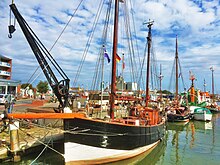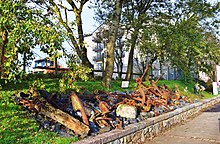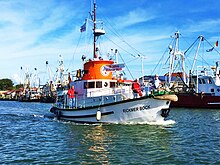Museum harbor Büsum
The Museum Harbor Büsum is a museum harbor in Büsum on the German North Sea coast .
After the founding of the Museumshafen Büsum eV on June 7, 2001 by 24 Büsum citizens and the takeover of the port basin I from the municipality of Büsum, the “old port” ( Low German “de ole Hoov” ) was converted into a museum port .
The association sees its task in providing evidence of maritime history , which have been saved from decay and the scrapping yard, as a guest and permanent berth as a home port. These decommissioned vessels of are commercial vessels acquired, restored and presented and kept going. The overall picture of the harbor is to be completed with the historical "Old Harbor" in order to be able to demonstrate to the present generation in an exemplary manner what commercial shipping once looked like on the west coast of Schleswig-Holstein , especially here in Büsum.
The port is currently more than busy due to a temporary construction bridge that separates the museum harbor into an active and passive part.
Port area
Harbor basin I is the closest harbor basin in Büsum to the city center and the beach. The development all around is shaped by the tourist character of the place; On the dike side, the mighty Hotel Lighthouse catches the eye, on the city side there is a row of shops that is mainly used by souvenir dealers. Opposite the narrow side of the port there is a wide flight of stairs that connect the port and the dike level. At first glance, the surrounding area does not look much like a museum, but from the harbor you also have a view of the Büsum barrel yard and lighthouse, and some sights around the harbor also point to the past:
- The anchor cemetery houses anchors of various types from several centuries; a notice board names the individual exhibits.
- Not far from the flight of steps is a replica of the Schottsche cart , as it was once used in the port area to transport fish and shrimp. Two more Schottsche carts are near the pier fire.
- There is a water level indicator or storm surge post nearby, from which the water level from disaster years can be read.
- An archaic "cup level" was used to display the water level during storm surges, next to it is an old tide level. Both can be found below the lighthouse next to the anchor cemetery.
- The first Büsum lighthouse, the predecessor of the lighthouse that went into service in 1913, was also recreated at the foot of the outside staircase. It consisted of a wooden cuboid substructure that carried a kerosene lamp and had been in service since 1878.
- On the land side there is still an old hand-operated crane that was used to load and rig the ships. The harbor crane dates from the time the Büsum fishing fleet was built. For example, the Carl Boysen engine workshop in Büsum, which was founded in 1917, used the crane to repair and maintain the engines of the fishing cutters. These were very heavy due to their large flywheels. The crane stands for the port development. It is a symbol of the arrival of modernity (combustion engine) in the North Sea fishery, which until then was under sail. The State Office for Monument Preservation Schleswig-Holstein has recognized the harbor crane in the museum harbor as a cultural monument and has included it in the list of monuments of the State of Schleswig-Holstein under object number 51465.
- One of the former pier lights at the harbor entrance from 1938 has served as a miniature lighthouse since 2003 at the angle between the museum harbor and harbor basin II. In the base of this turret, a cannon ball was walled in, which is said to come from the naval battle in which Danish and English gunboats collided off Büsum on September 3, 1813.
- Not far from this pier a Persiluhr was set up, which serves as a meeting point for city tours etc. The transition to the next harbor basin, where the excursion boats to Heligoland and the shrimp cutters leave, is also mainly used for tourism; Information boards on the history of the capture and processing of North Sea shrimp are also located on this harbor basin, on the other side of which is the Museum by the Sea, which is also dedicated to this topic .
vehicles
- The Rickmer Bock is owned by the Museum Harbor Association , which was commissioned as Hindenburg in 1944 but was renamed Privy Councilor Heinrich Gerlach that same year . The boat has had its current name since 1951. It was used as a motor lifeboat until 1981 , then was a museum ship in Bremen for 20 years and returned to its long-term location in Büsum in 2003.
- The former Finkenwerder deep-sea cutter "HF 316 Margaretha " is also owned by the association . It was built from oak in 1911 in Hamburg-Finkenwerder by Joachim Behrens. Its sail area is 75.5 m², the length over all 12.82 or 16.00 m with jib and the width 3.80 m. The gaff cutter has a diesel engine with 78 HP from 1985. It was used in the Elbe and coastal fisheries until 1957. In particular, flatfish, cod and turbot were fished for Hamburg. From 1957 to 1973 it was used under "DOR 54" in Dorum in coastal fishing for shrimp fishing. In 1973 it was taken out of the fishery and converted into a traditional ship. Since 2001 it has been owned by the Museum Harbor Association under "BÜS 39".
- The rescue cruiser " G. Kuchenbecker ", like the sister ship " H.-J. Kratschke ”of the 19-m class of the German Rescue Society (DGzRS) in 1969 from the Abeking & Rasmussen shipyard in Lemwerder and the two other sister ships“ Otto Schülke ”and“ Hans Lüken ”at the Schweers shipyard and boatyard in Bardenfleth, has been in the Büsum Museum Harbor next to the Rickmer Bock since July 12, 2019. Günter Kuchenbecker and Otto Schülke, both from Büsum, lost their lives together with their two other sea rescuers, the two Helgoland foreman Paul Denker and Hans-Jürgen Kratschke on February 23, 1967 when the rescue cruiser " Adolph Bermpohl " sank off Heligoland. A memorial stone next to the anchor cemetery commemorates the tragedy.
- The oldest still roadworthy shrimp cutter in Büsum is the Fahrewohl . It was built in Wewelsfleth in 1912 and had its home port in Büsum until 1921, where it won a regatta in 1914 and received its first engine in 1915. After years in Kaiser-Wilhelm-Koog , Cuxhaven and Friedrichskoog , where she served as a cutter until 1976, the Fahrewohl was bought by the Museum Harbor Association at the end of 2007 and transferred to Büsum in 2008.
- The Tierra del Fuego was built in 1927 for Gunther Plüschow and used by him for his expeditions. It has been back in Germany since 2006 and is to be completely restored for the museum harbor.
Web links
literature
- G. Timmermann: The secret of the Lühejolle , Yacht 36, 1939, 47, pp. 958-960.
- Büsumer Nachrichten October 14, 1920 Parish representative grants 5,000 marks to erect a crane at the harbor.
- Büsumer Nachrichten February 25, 1921 The port crane at the old port is ready.
- Büsumer Nachrichten December 2, 1994 Restoration is to take place.
- Dithmarscher Landeszeitung October 9, 2019 A centenarian needs help.
Coordinates: 54 ° 7 '38 " N , 8 ° 51' 30.8" E










